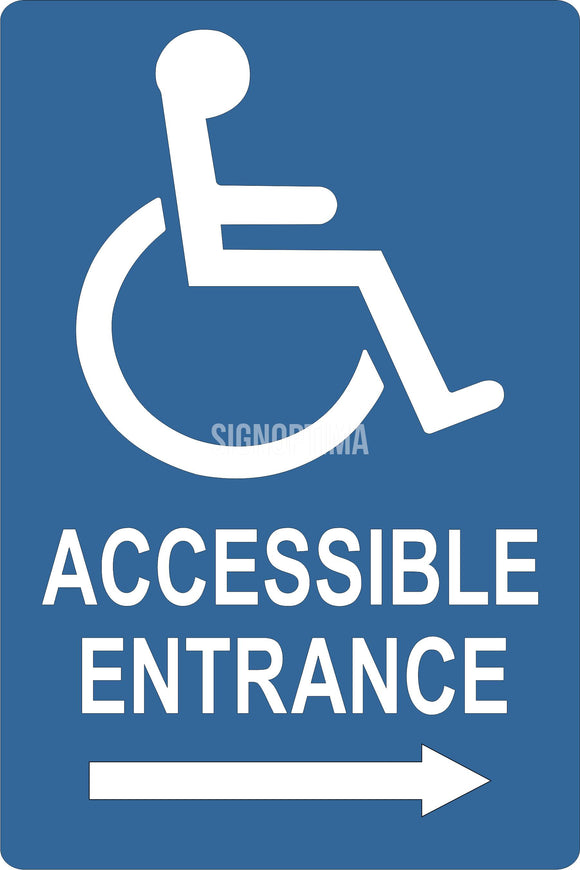ADA Signs: Crucial Devices for Inclusive Settings
Checking Out the Secret Functions of ADA Indications for Improved Ease Of Access
In the world of access, ADA indications serve as silent yet powerful allies, ensuring that rooms are inclusive and accessible for individuals with handicaps. By incorporating Braille and tactile components, these indications break barriers for the aesthetically impaired, while high-contrast color schemes and clear typefaces cater to diverse aesthetic demands.
Significance of ADA Conformity
Ensuring compliance with the Americans with Disabilities Act (ADA) is essential for promoting inclusivity and equivalent access in public areas and work environments. The ADA, enacted in 1990, mandates that all public facilities, employers, and transportation solutions suit people with impairments, ensuring they take pleasure in the very same rights and opportunities as others. Compliance with ADA requirements not just meets lawful commitments but also enhances an organization's track record by showing its dedication to variety and inclusivity.
One of the essential elements of ADA conformity is the execution of obtainable signs. ADA indicators are designed to ensure that individuals with disabilities can easily navigate via structures and rooms. These indications have to stick to details standards relating to dimension, font style, color contrast, and placement to ensure exposure and readability for all. Effectively implemented ADA signs helps eliminate barriers that individuals with handicaps often encounter, therefore advertising their self-reliance and self-confidence (ADA Signs).
Furthermore, sticking to ADA guidelines can reduce the threat of lawful repercussions and possible fines. Organizations that stop working to follow ADA standards may encounter fines or claims, which can be both financially challenging and harmful to their public image. Hence, ADA compliance is important to promoting an equitable setting for everybody.
Braille and Tactile Aspects
The unification of Braille and responsive elements into ADA signage personifies the concepts of ease of access and inclusivity. It is normally positioned beneath the matching message on signs to ensure that people can access the information without visual support.
Responsive components expand past Braille and consist of increased icons and personalities. These parts are made to be discernible by touch, allowing individuals to determine area numbers, restrooms, exits, and other important areas. The ADA sets specific standards relating to the size, spacing, and placement of these responsive components to enhance readability and guarantee consistency throughout different environments.

High-Contrast Color Systems
High-contrast color design play an essential duty in improving the presence and readability of ADA signs for people with aesthetic impairments. These schemes are important as they maximize the distinction in light reflectance in between message and background, making certain that indicators are conveniently discernible, also from a range. The Americans with Disabilities Act (ADA) mandates using specific color contrasts to suit those with restricted vision, making it a critical aspect of conformity.
The effectiveness of high-contrast shades hinges on their capability to attract attention in various lighting problems, consisting of poorly lit atmospheres and locations with glare. Usually, dark text on a light history or light message on a dark background is employed to accomplish optimum contrast. For example, black message on a white or yellow history provides a stark visual difference that assists in quick acknowledgment and comprehension.

Legible Fonts and Text Size
When thinking about the design of ADA signage, the selection of readable this contact form typefaces and ideal message size can not be overstated. These elements are important for making certain that indications are easily accessible to people with aesthetic disabilities. The Americans with Disabilities Act (ADA) mandates that fonts must be not italic and sans-serif, oblique, manuscript, extremely decorative, or of unusual type. These needs assist guarantee that the text is conveniently readable from a distance and that the personalities are appreciable to diverse audiences.
According to ADA standards, the minimum message height ought to be 5/8 inch, and it needs to boost proportionally with viewing range. Consistency in message size adds to a cohesive aesthetic experience, aiding people in navigating settings effectively.
Furthermore, spacing in between letters and lines is indispensable to legibility. Ample spacing avoids personalities from showing up crowded, enhancing readability. By sticking to these standards, developers can considerably improve availability, ensuring that signage offers its desired function for all people, despite their aesthetic capacities.
Effective Positioning Approaches
Strategic placement of ADA signage is important for making best use of accessibility and ensuring conformity with lawful requirements. ADA guidelines stipulate that indicators need to be placed at an elevation between 48 to 60 inches from the ground to ensure they are within the line of view for both standing and seated people.
Furthermore, signs must be positioned beside the latch side of doors to allow very Get the facts easy recognition before access. This positioning assists individuals locate areas and areas without obstruction. In cases where there is no door, indicators must be located on the closest surrounding wall surface. Consistency in indicator positioning throughout a facility boosts predictability, lowering confusion and boosting general user experience.

Verdict
ADA signs play a crucial duty in promoting access by integrating functions that resolve the needs of individuals with specials needs. Including Braille and tactile aspects makes certain vital details is accessible to the visually impaired, while high-contrast color design and legible sans-serif font styles improve presence throughout various lighting conditions. Efficient positioning approaches, such as ideal mounting heights and tactical places, additionally promote navigating. These components jointly foster an inclusive environment, highlighting the significance of ADA compliance in guaranteeing equal gain access to for all.
In the realm of accessibility, ADA signs serve as quiet address yet effective allies, making certain that spaces are comprehensive and accessible for people with specials needs. The ADA, established in 1990, mandates that all public centers, employers, and transportation solutions fit individuals with impairments, ensuring they take pleasure in the very same legal rights and opportunities as others. ADA Signs. ADA indications are created to make sure that individuals with handicaps can quickly navigate through buildings and rooms. ADA guidelines stipulate that indications ought to be placed at a height in between 48 to 60 inches from the ground to ensure they are within the line of view for both standing and seated individuals.ADA indicators play a crucial role in advertising ease of access by incorporating functions that address the demands of individuals with handicaps